Diopside
A pyroxene mineral found in igneous and metamorphic rocks. A minor gemstone.
Article by: Hobart M. King, PhD
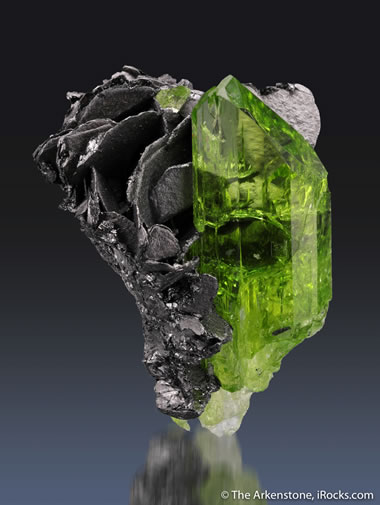
Diopside Crystal: A gemmy crystal of green diopside with excellent clarity grown on a crystallized graphite matrix. This specimen is from the Merelani Hills area of Tanzania, which is also famous for its Tanzanite mines. The specimen measures 2.2 x 1.8 x 1.5 centimeters. Specimen and photo by Arkenstone / www.iRocks.com.
What is Diopside?
Diopside is a rock-forming pyroxene mineral with a chemical composition of MgCaSi2O6. It occurs in igneous and metamorphic rocks at many locations around the world.
Gem-quality crystals of diopside are faceted into attractive gemstones that are occasionally seen in commercial jewelry. Granular diopside can be easily cut and polished. When it has an attractive color, it is sometimes used as an ornamental stone.
Perhaps the most important use of diopside is its value as an indicator mineral in the search for diamonds. Trail-to-lode prospecting using diopside and other indicator minerals has found diamond deposits in Canada, the United States, Africa, and other locations.
Diopside has potential uses in the glass and ceramics industries, but the mineral usually occurs in accumulations that are too small or impure for effective mining.
Physical Properties of Diopside |
|
| Chemical Classification | Silicate. |
| Color | Grayish white, light blue to purple, light green to vivid green, brown, black. |
| Streak | White to light green. |
| Luster | Vitreous, sugary, earthy. |
| Diaphaneity | Opaque, translucent, transparent. |
| Cleavage | Two distinct directions, at 87 and 93 degrees; imperfect; prismatic. |
| Mohs Hardness | 5.5 to 6.5 |
| Specific Gravity | 3.2 to 3.5 |
| Diagnostic Properties | Cleavage, monoclinic crystal form. |
| Chemical Composition | MgCaSi2O6 |
| Crystal System | Monoclinic. |
| Uses | Gemstone, diamond indicator mineral, potential industrial use in ceramics. |
Geologic Occurrence of Diopside
The most common occurrence of diopside at Earth's surface is as a primary mineral in olivine-rich basalts and andesites. In these rocks it can be present in quantities of a few weight percent.
Diopside also forms during contact metamorphism of limestones and dolomites. Most of the crystalline diopside used to cut faceted gems and the granular diopside used as ornamental stone occurs in these carbonate deposits.
Diopside is much more abundant in Earth's mantle than at the surface. Evidence for this is diopside as a common mineral in ophiolites, and diopside as a common mineral in kimberlites and peridotites that were formed during deep-source volcanic eruptions.

The best way to learn about minerals is to study with a collection of small specimens that you can handle, examine, and observe their properties. Inexpensive mineral collections are available in the Geology.com Store. Image copyright iStockphoto / Anna Usova.
Diopside as a Diamond Indicator Mineral
Most diamonds found at or near Earth's surface were delivered from the mantle during deep-source volcanic eruptions. These diamonds occur in vertical igneous structures known as pipes, which are often composed of kimberlite or peridotite.
These pipes are difficult to locate. Their surface exposure is usually covered with soil and vegetation, and it might be only a few acres in size. The pipes are often found by searching soils and sediments for mineral grains that are characteristic of the pipe but absent in local surface materials. Small particles of chromium-rich diopside are bright green in color, are often abundant in the pipes, and are easy to recognize in surface materials.
Geologists use these green diopside fragments to locate the pipes. They know that the fragments are liberated as the pipe weathers, then scattered by the actions of mass wasting, streams, and glaciers. When diopside fragments are discovered, the geologist knows that they originated up-slope, up-stream, or up-ice from the location in which they were found.
A trail of diopside fragments can lead the geologist to the pipe from which they were weathered. This activity, known as "trail-to-lode" prospecting, finds many diamond pipes and an even larger number of pipes without diamonds.
Note: It would be almost impossible to locate pipes by looking for diamonds. Diamonds make up such a small fraction of the overall rock in the pipe, and weathering debris from the pipe is then mixed into local rock debris. An exceptional pipe might contain a couple carats of diamond per ton!
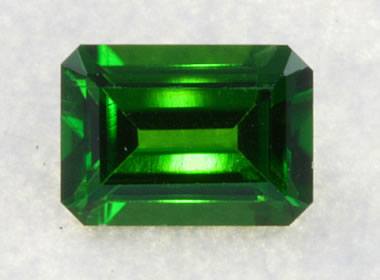
Chrome Diopside Gem: A faceted stone cut from chrome diopside mined in Russia. This gem is approximately 1.2 carats in weight and about 7 millimeters by 5 millimeters in size.
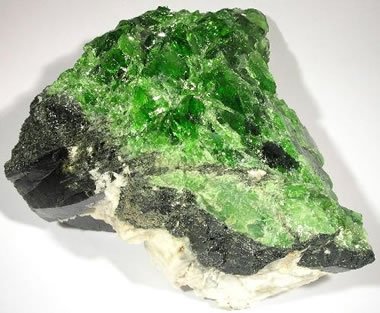
Chromium Diopside: A gemmy green specimen of chromium diopside from the Outokumpu copper-zinc mining district in Finland. This specimen measures 6.5 x 6.2 x 2.9 centimeters in size. Specimen and photo by Arkenstone / www.iRocks.com.
Chrome Diopside
Some crystals of diopside contain enough chromium to give them a rich green color. These can be cut into beautiful faceted stones, beads, and cabochons. The appearance of these stones is best when they are under two carats because the material is often dark or strongly saturated.
Chrome diopside is occasionally seen in commercial jewelry. It has a rich green color that enables it to serve as an alternative gem for emerald at a significantly lower price. Diopside is rarely treated, unlike emerald which is often treated with various materials to seal and hide fractures.
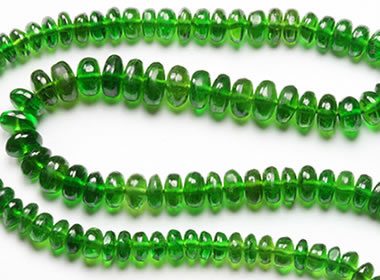
Chrome Diopside Beads: Rondelle-shaped beads cut from bright green chrome diopside mined in Russia. The beads range in size between 3 and 5 millimeters in diameter.
One problem with chrome diopside is its durability. It has two directions of perfect cleavage and a Mohs hardness of only 5.5 to 6.5. This gives it a risk of being scratched or broken. The gem is best used in earrings, necklaces, brooches, and other items that will not be subjected to abrasion or impact.
Even though chrome diopside is very attractive, there are barriers to it becoming a popular gem that is widely seen in jewelry. First are the durability concerns described above; second is that the jewelry-buying public is not familiar with diopside; and, third is the fact that a reliable supply of commercial stones in calibrated sizes has not been developed.
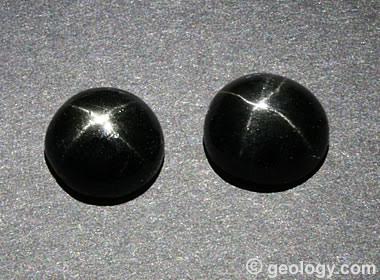
Star Diopside: Black star diopside cabochons exhibiting four-ray stars. They are slightly magnetic, indicating that the silk is probably magnetite crystals. These cabochons are approximately 8 millimeters across, and we paid less than $30 for the pair.
Star Diopside
Some diopside crystals are filled with microscopic needle-shaped inclusions that occur in a parallel alignment through the crystal structure of the mineral. This network of parallel inclusions is known as a "silk." When this diopside is cut en cabochon, the parallel needles of the silk can reflect light much like how light is reflected from a spool of silk thread.
A silk with one direction of needle alignment will produce chatoyance, also known as a cat's eye. Silk with two or three directions of needle alignment will produce asterism. Two directions will produce a four-ray star, and three directions will produce a six-ray star.
In star diopside there are two directions of needle alignment, producing a four-ray star. The star is often strong and straight in one direction but weaker and slightly wavy in the second. A thin white or silver star on a jet-black cabochon is characteristic of star diopside.
For the star phenomenon to appear, the rough must be oriented so both silk directions and the flat bottom of the cabochon are all aligned in the same plane. In addition, the top of the cabochon must be symmetrically cut. Without this precise cutting, the star will be off-center. If the directions of the star do not intersect at 90 degrees, it is not a result of poor orientation of the rough during cutting. The directions of the silk do not intersect at precisely 90 degrees.
The mineral needles that form the silk are known in some instances to be magnetite. They are sometimes abundant enough to make the cut gems slightly magnetic. If you approach them slowly with a magnet, the gems will move before the magnet touches them. The needles in some non-magnetic gems can be rutile or ilmenite. A silk made up of heavy mineral crystals will give star diopside a higher specific gravity than other specimens of diopside.
Star diopside is one of the least expensive gems with obvious asterism. Small cabochons (6 or 8 millimeters) with a clear star can often be purchased for under $30. Larger stones or those with exceptional stars will sell for a lot more. They are a nice way to obtain a star gem without paying the high cost of star sapphire.
Star diopside has a hardness of just 5 1/2. This makes it easy to scratch if used in a ring, bracelet, or cufflinks. Small stones are best used as earrings. Rare large stones can make nice pendants.
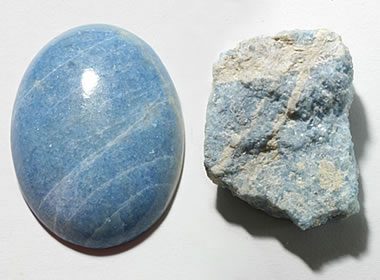
Violane: A rarely seen variety of diopside is violane. It is usually a blue to purple material that is cut into beads and cabochons. The photo shows a cabochon and a piece of rough from the Khakassia area of Russia. This cabochon is approximately 38 x 28 millimeters in size.
Violane
Some diopside that was formed during the contact metamorphism of dolomite or limestone has a granular texture similar to marble. This material is known as "violane." It is often white, gray, light blue, lilac, or purple in color. Violane accepts a bright polish and is sometimes used to make cabochons, beads, and ornamental items. Violane is a rare material in nature and is almost never seen in commerce.
Diopside as an Industrial Mineral
Diopside has potential uses in ceramics, glass-making, biomaterials, nuclear waste immobilization, and fuel cell technology. Unfortunately, natural diopside is rarely found in deposits that simultaneously have a size, purity, and location that allows economic mining. This makes synthetic diopside cost-competitive with diopside produced by mining.
Geographic Distribution of Diopside
Gem-quality chrome diopside and violane are mined in limited amounts in Siberia, Russia. Most of the chrome diopside used in jewelry today comes from a few locations in Siberia. Small occurrences of chrome diopside are also known in Austria, Brazil, Burma, Canada (Ontario and Quebec), Finland, India, Italy, Madagascar, Pakistan, South Africa, Sri Lanka, and the United States (New York), but none of them produce regularly or in significant quantities.
| More Minerals |
 |
Herkimer Diamonds |
 |
The Acid Test |
 |
Tumbled Stones |
 |
Zircon |
 |
Fool*s Gold |
 |
Kyanite |
 |
Rock Tumblers |
 |
Rhodochrosite |

Find Other Topics on Geology.com:

|

| ||

|

| ||

|

| ||

|

|
